After some wonderfully warm days the other week, the temperature has dropped again. It was raining the last few days too, so Pumpkin and I are trying to stay warm. I wish I could do it as stylishly as he…
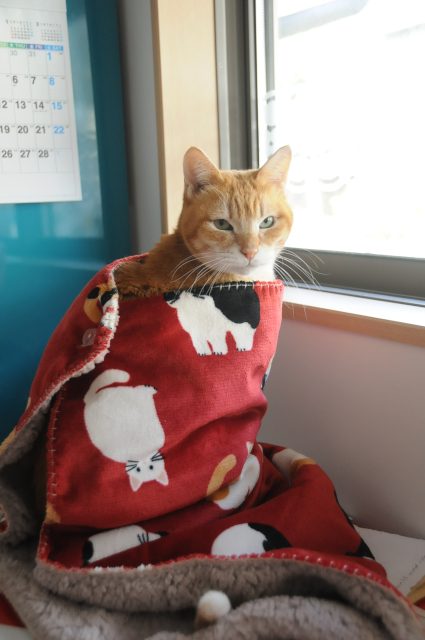
A European's move towards Japan
After some wonderfully warm days the other week, the temperature has dropped again. It was raining the last few days too, so Pumpkin and I are trying to stay warm. I wish I could do it as stylishly as he…

Zori are a type of Japanese-style flip flops. Traditionally, farmers made them during winter using rice straw from their fields. They were meant as footwear for outdoors and pretty much everybody wore them when walking short distances.
Interestingly, they are fairly durable. Remember that in the olden days of Edo, the streets were not paved, so little stones would get stuck in the gaps between the straw and over time create a durable sole. On wood surfaces or even tatami this would be disastrous, hence, they were always taken off before entering a home or temple.
Zori are still quite popular, and nowadays, they are also made from fabric, but this version is meant for indoors. They can be very colorful, and they are very comfortable in summer when it’s too hot for socks or slippers and you still don’t fancy walking barefoot.
Below is a video (in Japanese with subtitles) that teaches the process of making zori from old t-shirts step-by-step. It’s quite a way to go until summer, but it’s good to get a head start.
I’m busy today getting ready for this year’s very first BATI-HOLIC solo concert (aka in Japanese: one-man show). The place is fairly small and they sold out last week, and since I’m planning to stand in the first row, thank you, I’ll better be there before the doors open. I’ll check in later!
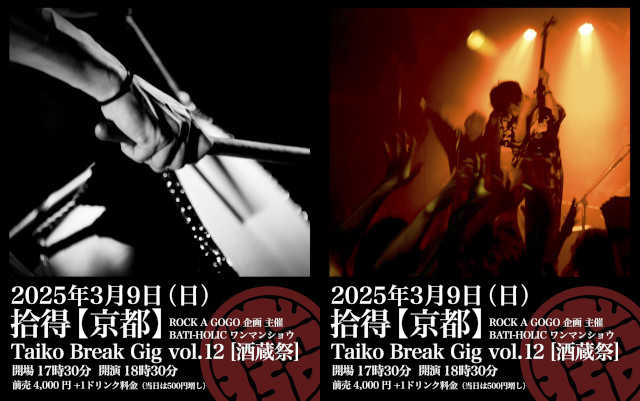
Later: This was so much fun! It’s great when the people are all fans of the band and go with the music. I didn’t quite make it to the first row, but I could secure a seat on a platform with tatami and small tables, and it’s easy to get up and dance there. It was perfect!
One thing I find always very interesting at such concerts is how quickly people tend to leave when everything is over. Some 15 minutes after the last encore, the place was half empty already. I stuck around with some friends, and I enjoy this part of chatting and drinking and having fun with them and the band members just as much as the music itself.
Goodness, I’m not turning into an extrovert, am I?
I’ve told you often enough that I don’t like winter here because it is so cold in the house. Another reason I don’t like winter much is that I can’t sleep properly. That has nothing to do with the cold bedroom, though. The problem is Pumpkin and the fact that my little furball is cold too.
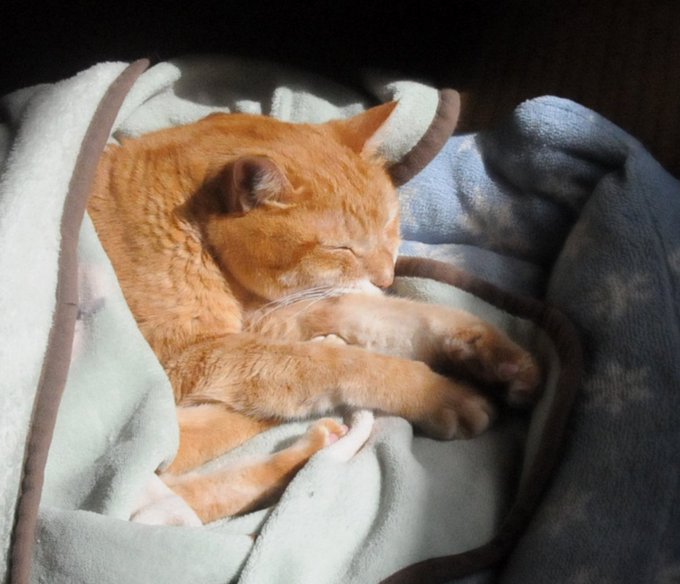
As I mentioned before, I have a heavy woollen duvet in my bed plus a fleece blanket on top. Together they keep me wonderfully warm even when the room temperature drops down to 5 degrees or below. On such cold nights, Pumpkin insists on sleeping with me underneath the duvet, and because it’s so heavy, he needs me to lift it up for him a little so he can get inside. Our bedtime routine is such that he’s waiting until I turn off the light before gently scratching the pillow next to my head so I can let him in.
So far, so good. The problem is that while I need eight hours of beauty sleep, Pumpkin certainly doesn’t. He slips out of the bed several times at night to eat and drink, to go potty… And then he wants to get back underneath the covers. When I’m asleep, I don’t react to gentle scratches – so he meows instead. Straight into my ear. Loudly. In other words, he wakes me up several times a night because he’s cold. So far, so bad.
I’ve tried this year to teach him to sleep between the duvet and the fleece blanket. The latter is much lighter, so he can get underneath it without my help. He was not very happy about this for a while – it is not quite as warm as curling up next to my body. But finally, I can report that yes, he got it.
The last few mornings I found him curled up underneath the fleece blanket only, and blissful nights of uninterrupted sleep these were! He now even wants me to tuck him in when he takes his afternoon nap in my bed. It’s those little wins. I just hope he remembers this until next winter…
Tomorrow is hina matsuri, the doll or girl festival. Traditionally, it was meant as a purification rite / blessing for girls, and to this day, there are religious ceremonies in many shrines in the country.
During the Edo period, the custom of setting up so-called hinadan with dolls in homes with girls started – ideally, one for each girl. The most elaborate hinadan have seven tiers, starting at the top with a pair of dairi-bina, which are accompanied on lower tiers by ladies-in-waiting, musicians, guards, and gardeners. Other tiers showcase miniature household goods that a young lady of means could not do without.
Growing up in a small house with lots of stuff that I wasn’t allowed to touch, I don’t usually put up seasonal decorations. However, there is something about hina matsuri that makes me give in, and I bought a very modern dairi-bina pair a few years ago. And then, last year, a friend of mine gave me a super cute pair of dairi-bina in the shapes of my zodiac animal, so…
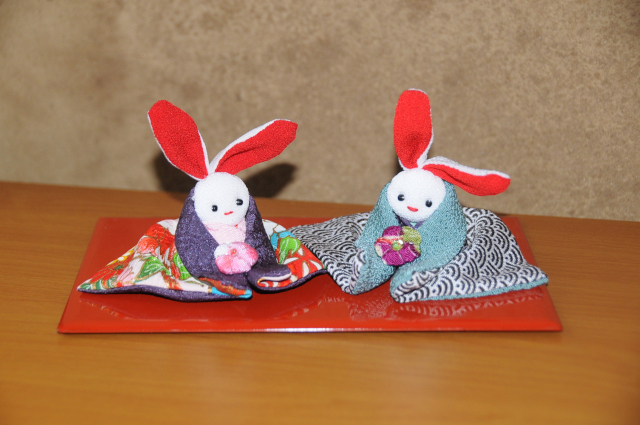
Things have got really expensive here during the last year. Obviously, a large part of this is because the yen is so weak, so all the prices for imports have skyrocketed (except tourists, they come for free it seems…) But also local products have increased in price, in particular: rice.
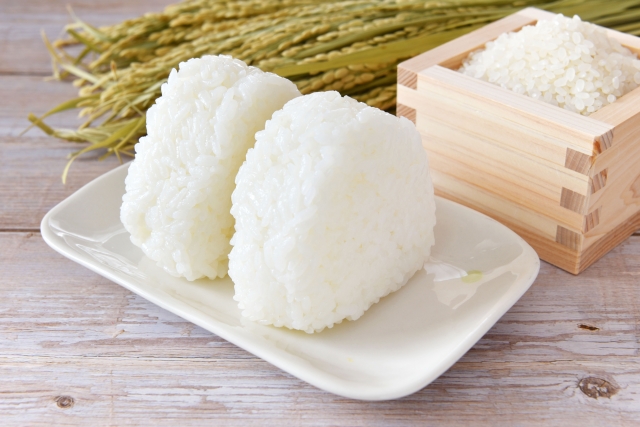
Compared to normal Japanese people, I eat comparatively little rice, a large bag lasts me several months. Therefore, I tended to watch the sales and usually bought my rice at around 1,980 yen for five kilos of Akitakomachi rice from Akita prefecture. This very same rice at the very same supermarket now goes for 4,090 yen (without sales) for five kilos. I’m quite shocked.
The reason is inflation and high prices all around, but also because there was a quite bad harvest last year because of dry weather; typhoon-related floods also diminished the harvest in other areas of Japan. On top of all that, there was an “advisory” by the JMA (Japan Meteorological Agency) last August about the increased risk of a megaquake along the Nankai Trough, that stretches from central to southwestern Japan in the Pacific Ocean. Note that they also mentioned something about “in the next 100 years”, which didn’t prevent people from stockpiling rice immediately.
In response to the price hike, the Japanese Government has decided to sell about 10% of their rice reserve of 1,000,000 tons to keep prices stable. So far, I haven’t seen much movement in prices; the cheapest 5 kilos at the cheapest supermarket are 3,180 yen right now. I’m wondering if any of that cheap rice will make it to Kyoto or even any of the rural areas at all. I’ll keep you posted.
Futaro Yamada
Tokyo, 1869. Two years after the Meiji Emperor took the throne, the country still reels from the aftermath of the Boshin Civil War. Yet, the government, now relocated to Tokyo (formerly known as Edo) tries to regain control and establishes an executive and judicial system after Western examples. The newly established Imperial Prosecuting Office is tasked with tackling the rampant corruption within the government itself.
Chief inspectors Kawaji and Kazuki are two brilliant detectives who are just the right people for this task. Together, and with the help of a shrine maiden who can summon the dead, they solve five impossible seeming murders of minor officials. However, are these murders as unconnected as they seem – or is there somebody pulling the strings from behind?
This historical crime novel is a fairly slow book. The first 100 pages or so only set the scene and introduce us to minor and major characters. The five cases are independent of each other and are solved as such. The puzzles are interesting and fun to solve, but there is no indication that there may be a mastermind behind all the murders; when his identity is revealed, it comes as a shock.
The introduction of the miko-medium to solve the murders seemed strange to me (Shinto doesn’t really deal with death), but since Yamada makes her a foreigner (who may have her own powers), I’ll forgive him for this.
Futaro Yamada was born 1922 in Hyogo Prefecture and studied medicine at Tokyo University. His first short story “The Incident at the Dharma Pass” was published in 1947, and he went on to write more than 100 novels and short stories in his lifetime. In Japan, his best-loved works are historical crime and ninja novels, and many of his books have been adapted for film or manga and anime. He died in 2001.
If you’re ready for something different with a long lead-in to set the scene, give this a try. You can get the book on amazon.
When I woke up this morning at eight, it only had 2 degrees in my bedroom. On such days, I tend to stay in bed until Pumpkin demands his breakfast. But today I had an early meeting: the press conference for this year’s Miyako Odori.

It was similar to last year’s press conference, just a bit smaller because it’s not a milestone anniversary.
After the talks and Q&A by the officials involved in the dance production (just like last year, the dance master and a university professor), the painter of the official portrait that is used for the flyer was introduced. I haven’t looked at my photos from last year, but I’m pretty sure it’s the same woman.
In contrast, the young lady to the left is brand new. Her name is Katsuwaka, she is from Niigata and merely 17 years old. Last year she had her “misedashi” – introduction as a maiko – and this year, she will make her stage debut at the Miyako Odori. She was even interviewed, it must be a big thing for her (and the kagai as a whole).
This year’s theme is “Colorful Seasons of Kyoto” and some of the eight scenes are set in famous places like Kiyomizudera, Heian Jingu, Umenomiya Taisha and Gion of course. While last year was all about the Tale of Genji, this year’s program will stray a little from the formality of the Heian court. At least, that’s what I’m led to believe from looking at some of the costumes. I’m really looking forward to seeing the performance this year!

Again, the look behind the scenes was quite illuminating. It’s fascinating how much work goes into all this; only arranging the promotional photo in front of the large silver doors took about half an hour, not to mention dozens of people behind the camera.

It snowed this afternoon, for the first – no, second – time this winter. I was super happy and went for a short walk that ended at my second-most favourite cafe with chai and brownies.
So far, and I’m writing this at 10 in the evening, it’s not enough snow to cover the ground, but some forecasts promise more in the weekend. We’ll see. Right now, the internet says it’s -1 degrees outside, but thanks to windchill it feels like -8. Looks like I’ll be going to bed soon, Pumpkin snuggles up to me already.
Last week was pretty busy. On top of work, I went to three exhibitions, one shrine, one sake brewery tour (with tasting afterwards), and finally on Sunday: a BATI-HOLIC concert. I was pretty exhausted by then, but it was good.
This week, since I don’t have any appointments, I’m trying to catch up on a few things website and writing-related. And there’s another exhibition I want to see. So much to do in Kyoto!
I’ve been very busy since last week, so much to do…
I went to two exhibitions, one with nihonga, Japanese-style paintings, and one with contemporary art. The nihonga exhibition is a biennial exhibition that was established in 1898, and I’ve been there before. This time, there were only two or three paintings that touched me, a pity.
The contemporary art was by Mika Ninagawa (and team) and it was 10 rooms of art installations. Some of them were with projections and films, others with tangible art. My favourite room or “picture” as she called it was 1500 strings with crystals hanging from the ceiling, meant to represent the sparkle of life. I thought it was especially uplifting and cheerful, standing out from the rest of the exhibition, which was very colorful as a whole. As I mentioned on my x account, I got the only black and white postcard…

Besides that, my friend from Tokyo visited me, and we went on a tour through a sake brewery not far from Demachiyanagi. The tour was quite short because the brewery is one of the smallest in Kyoto, but it came with sake tasting afterwards. Sadly, they are not open in the evenings, and I’m not into day drinking at this time, but I’ll keep them in mind if and when I need gifts for friends in the future.
Last weekend I went to one flea market and one handicraft market and I had a blast chatting with the vendors. They would’ve appreciated me buying stuff, but there’s only so much money I have right now.
Next Sunday is Setsubun and while I would love to go to a lucky bean scattering at a shrine, there is also the next BATI-HOLIC concert in the evening… I’ll have to do some careful planning for this one.